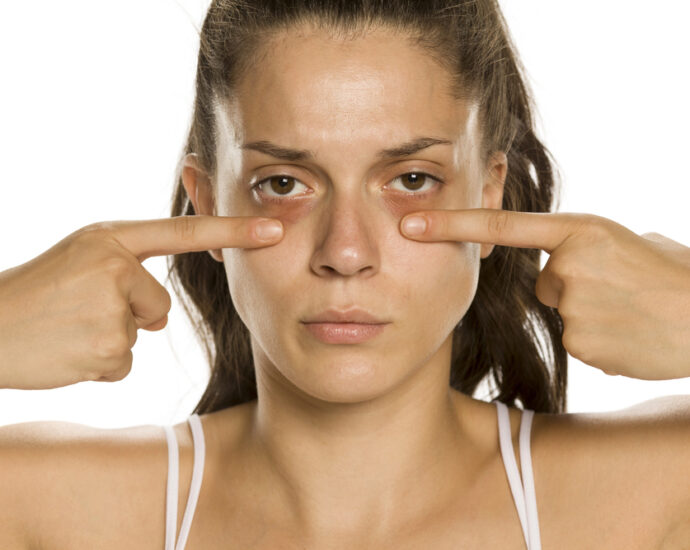Dark circles under the eyes are one of the most common cosmetic concerns for both men and women. While they are not usually a medical problem, they can make a person look tired, older, or less healthy. Many people seek solutions to reduce or eliminate dark under-eye circles, but understanding the underlying causes is essential to finding the most effective treatment.
This article explores what causes dark circles, available treatment options, and practical prevention tips, giving you a complete guide to managing this frustrating condition.
Page Contents
What Are Dark Circles Under the Eyes?
Dark circles, medically referred to as periorbital hyperpigmentation, are areas of darker skin under the eyes. They can appear bluish, purple, brown, or black, depending on skin tone, blood vessel visibility, and pigmentation changes.
Unlike temporary puffiness, dark circles often persist and may worsen with age or certain lifestyle habits. They are not harmful but can significantly affect appearance and self-confidence.
Common Causes of Dark Eye Circles
There is no single cause of dark circles; instead, multiple factors can contribute, often overlapping.
- Genetics and Skin Type
- People with naturally thin or fair skin may have more visible blood vessels beneath the eyes.
- A family history of dark circles increases the likelihood of developing them.
- Aging
- With age, skin loses collagen and becomes thinner, making veins and underlying structures more noticeable.
- Hollowing under the eyes (tear troughs) can create shadows that look like dark circles.
- Lack of Sleep and Fatigue
- Sleep deprivation can cause paleness, making blood vessels under the eyes more prominent.
- Tiredness may also lead to fluid accumulation, creating puffiness that casts shadows.
- Allergies and Nasal Congestion
- Allergic reactions trigger histamine release, causing swelling and blood vessel dilation.
- Chronic nasal congestion can darken the under-eye area, often called “allergic shiners.”
- Hyperpigmentation
- Overproduction of melanin can cause darkening of the skin under the eyes.
- More common in people with medium to darker skin tones.
- Lifestyle Factors
- Excessive sun exposure increases melanin production and worsens pigmentation.
- Smoking, dehydration, and alcohol use can make circles more noticeable.
- Poor diet lacking essential nutrients may affect skin health.
- Medical Conditions
- Thyroid issues, eczema, and anemia may contribute to under-eye darkness.
- Persistent dark circles that do not improve with rest should be evaluated by a doctor.
Types of Dark Circles
Understanding the type of dark circles is important for choosing the right treatment:
- Pigmented dark circles: Caused by excess melanin, usually brown in color.
- Vascular dark circles: Bluish or purplish tint due to visible blood vessels.
- Structural dark circles: Caused by skin thinning, hollowing, or shadows under the eyes.
- Mixed dark circles: A combination of pigmentation, vascular, and structural causes.
Treatments for Dark Circles
There is no one-size-fits-all treatment, but various approaches can help reduce their appearance.
- Home Remedies and Lifestyle Changes
- Adequate sleep: Aim for 7–9 hours of quality sleep each night.
- Cold compresses: Reduce swelling and shrink dilated blood vessels temporarily.
- Hydration: Drinking enough water keeps skin plump and healthy.
- Balanced diet: Foods rich in iron, vitamin K, and antioxidants support skin health.
- Sun protection: Sunscreen and sunglasses reduce pigmentation and UV damage.
- Over-the-Counter Treatments
- Eye creams with retinol: Boost collagen production and thicken skin.
- Vitamin C serums: Brighten skin and reduce pigmentation.
- Caffeine-infused creams: Constrict blood vessels and reduce puffiness.
- Hyaluronic acid creams: Hydrate and plump thin skin.
- Medical and Cosmetic Procedures
When topical treatments are not enough, dermatologists may recommend advanced options:
- Chemical peels: Lighten pigmented dark circles by removing damaged skin layers.
- Laser therapy: Targets pigmentation and improves skin texture.
- Dermal fillers: Fill hollows under the eyes to reduce shadowing.
- Microneedling: Stimulates collagen production to thicken under-eye skin.
- Platelet-rich plasma (PRP) therapy: Uses growth factors from your own blood to rejuvenate skin.
- Treating Underlying Conditions
- Allergy medications can reduce swelling and vascular dark circles.
- Iron supplements may help if anemia contributes to under-eye darkness.
- Managing eczema or thyroid conditions may also improve symptoms.
Preventing Dark Circles
While not all causes are preventable, certain habits can minimize their severity:
- Maintain a consistent sleep schedule.
- Apply sunscreen daily, even under the eyes.
- Wear sunglasses to protect delicate under-eye skin.
- Avoid rubbing the eyes, which can worsen pigmentation.
- Stay hydrated and limit caffeine/alcohol.
- Quit smoking to improve circulation and skin quality.
When to See a Doctor
Most dark circles are harmless, but medical advice is recommended if:
- They appear suddenly without clear cause.
- They are accompanied by swelling, pain, or skin changes.
- They do not improve with rest or lifestyle adjustments.
- There are symptoms of underlying health issues, such as persistent fatigue or thyroid changes.
A dermatologist or healthcare provider can help determine the cause and recommend tailored treatment.
Conclusion
Dark circles under the eyes are a common concern with multiple causes, ranging from genetics and aging to allergies and lifestyle factors. While they are rarely a sign of serious illness, they can impact self-esteem and appearance.
Fortunately, numerous treatment options—from simple home remedies to advanced dermatological procedures—can reduce or eliminate dark circles. Combining lifestyle improvements with targeted therapies is often the most effective approach.
By understanding the underlying cause and seeking appropriate care, you can brighten your under-eye area and restore a more refreshed, youthful appearance.
READ MORE: Skin Care: When To See A Dermatologist
Sources:
https://pmc.ncbi.nlm.nih.gov/articles/PMC3969674/
https://my.clevelandclinic.org/health/symptoms/23128-dark-circles-under-eyes
https://www.theblondeinjector.com/blog/5-treatments-to-get-rid-of-dark-under-eye-circles
